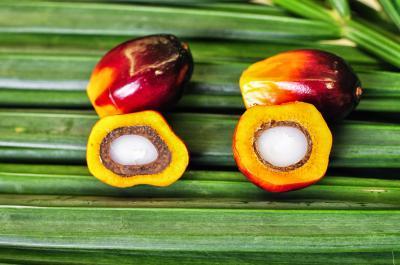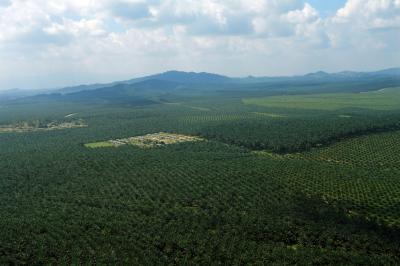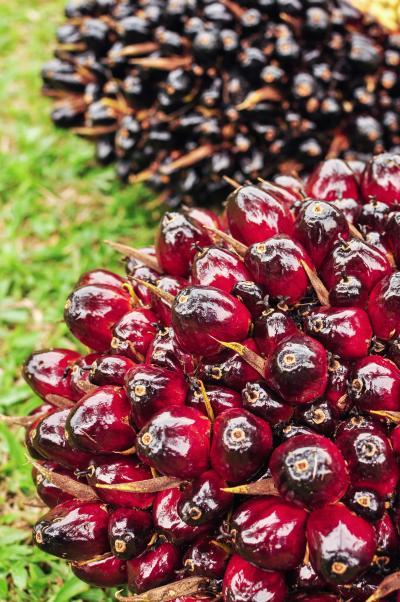The identification of a single gene critical for yield of the oil palm, a crop that accounts for nearly half of world-wide edible vegetable oil, is reported along with the plant's genomic sequence in a set of papers published online July 24, 2013 ahead of print in Nature. The findings have implications for enhancing the future production and sustainability of palm oil, including a reduction in the pressure this productive tropical crop exerts on the footprint of wild rainforests. The work was authored by investigators from the Malaysian Palm Oil Board (MPOB) and Orion Genomics.
"Our team identified an oil yield-related gene called Shell and discovered mutations in this gene that explain the single most important economic trait of the oil palm: how the thickness of its shell correlates to fruit size and oil yield. This discovery may help balance the competing interests of meeting increasing world-wide demand for edible oil and biofuels on the one hand, and of rainforest conservation on the other," notes author Rajinder Singh, Ph.D., Head of the Genomics Unit of the Advanced Biotechnology and Breeding Centre, MPOB.
The African and S. American oil palms, Elaeis guineensis and Elaeis oleifera, produce palm oil and together account for 45 percent of the edible vegetable oil worldwide. The new research identified the gene, Shell, responsible for the three known shell forms: dura (thick), pisifera (shell-less) and tenera (thin), a hybrid between dura and pisifera palms. Tenera palms contain one mutant and one normal Shell allele, an optimum combination which results in 30 percent more oil per land area than dura palms.
Until now the mapping of Shell has been extremely challenging because of the plant's large genome and long generation times as well as the difficulty in typing the widely distributed experimental oil palm populations.

Fruit of the oil palm is showing the thick-shelled fruit (Dura) on the left and thin-shelled fruit (Tenera) on the right. Tenera fruits yield 30 percent more oil per fruit than Dura fruits.
(Photo Credit: MPOB)
The discovery of the Shell gene and its two naturally occurring mutations highlights new molecular strategies to readily identify those seeds or plantlets which will become high yielding palms before they are introduced into plantations, the authors note.
For example, seed producers and plantation owners can now use the genetic marker for the Shell gene to distinguish the three fruit forms in seeds and seedlings long before they are field-planted. Currently, it can take six years to identify whether an oil palm plantlet is of the desired shell type. The genetic marker will also be an important quality control tool in commercial seed production as up to 10 percent of plants may be the low yielding dura form due to uncontrollable wind and insect pollination.
"Accurate genotyping for enhanced oil yields will optimize and help stabilize the acreage devoted to oil palm plantations, providing an opportunity for the conservation of rainforests," says primary author Robert A. Martienssen, Ph.D., scientific co-founder of Orion Genomics, who is also a Howard Hughes Medical Institute Investigator and Gordon and Betty Moore Foundation Investigator and Professor of plant genetics at Cold Spring Harbor Laboratory in New York.
"As the second largest producer of palm oil in the world, Malaysia has a responsibility to make advancements that will improve the sustainability of oil palm agriculture, while improving yields for growers. The genome mapping of the two oil palm species will pave the way for many more breakthroughs. Together, this will help meet the increasing global demand for food and biofuels worldwide while simultaneously preserving wild lands," said Datuk Dr. Choo Yuen May, Director General of MPOB, which funded and led the research reported in both papers.

This image shows oil palm plantations in Malaysia.
(Photo Credit: MPOB)
Over five decades, MPOB has amassed more than 100,000 wild oil palm plants. The investigators used this collection, along with carefully designed genetic crosses to identify the Shell gene and its two mutations.
The researchers, as reported in a second paper in Nature, also mapped the genomes of both oil palm species. "The oil palm genomes are a rich resource for palm breeders, geneticists and evolutionary biologists alike and will facilitate future identification of genes responsible for important yield and quality traits such as fruit color, disease resistance and height," explains primary author Ravigadevi Sambanthamurthi, PhD, who heads the Oil Palm Genome Program and is the Director of MPOB's Advanced Biotechnology and Breeding Centre.
One of the reported maps is the 1.8 gigabase sequence of the E. guineensis African oil palm, tallying nearly 35,000 genes, including the full set of oil biosynthesis genes and other transcriptional regulators highly expressed in the oil-rich palm fruit. The researchers also created a draft sequence of the South American oil palm E. oleifera. Both palm species are in the Arecaceae family of flowering plants, which dates via fossils to the Cretaceous period, an estimated 140 to 200 million years ago. The investigators' comparison of the two maps enabled them to estimate that the oil palm species diverged at the old world- new world split.

Oil palm is showing bunches of the fruit that yield palm oil.
(Photo Credit: MPOB)
Source: Canale Communications